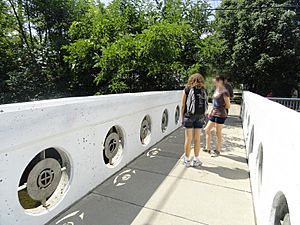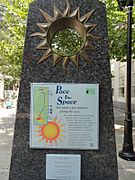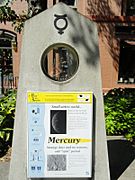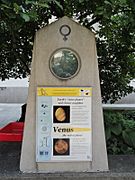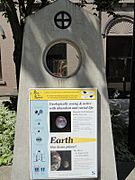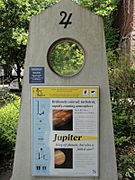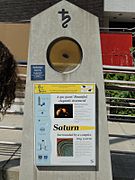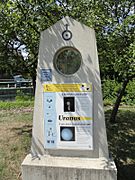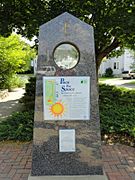Sagan Planet Walk facts for kids
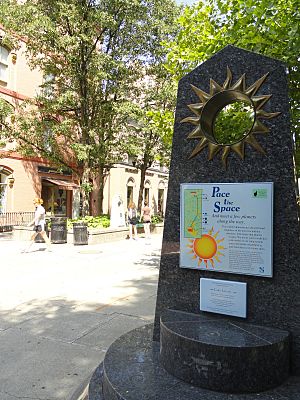
The Sagan Planet Walk is a super cool outdoor exhibit in Ithaca, New York. It's like a giant, walkable model of our Solar System! Everything, from the size of the planets to how far apart they are, is shrunk down to one five billionth of its real size. This amazing walk was created in 1997 to remember Carl Sagan, a famous scientist and professor from Cornell University who lived in Ithaca.
The Planet Walk has eleven special pillars, called obelisks. They are spread out along a 1.18 km (0.73 mi) path through downtown Ithaca. The walk starts with the Sun at Center Ithaca and ends with Pluto at the Ithaca Sciencenter. In 2012, the model got even bigger! It now includes a representation of Alpha Centauri, the closest star to our Sun. This new part is 7,630 kilometers (4,740 mi) away at the ʻImiloa Astronomy Center in Hawaii. Adding Alpha Centauri made the Sagan Planet Walk the biggest exhibit of its kind in the world!
In 2014, some parts of the walk, like the Sun and inner planets, were moved because of construction. But don't worry, they've been put back! There are also plans to add a station for an exoplanet called Kepler-37d on the Moon, which is 384,500 kilometers (238,900 mi) away.
Contents
How the Models Work
Each planet's station has a 6 ft (1.8 m) tall pillar, or obelisk. At the top of each obelisk, there's a circular frame that's 27.8 cm (10.9 in) wide. This frame shows you how big the Sun would be at this scale. Inside this Sun-sized frame, you'll see a small sphere or a hole that shows the correct size of the planet. The places for each planet were chosen carefully. They show the right distance and also highlight cool spots in Ithaca. Some of the original planet models were changed in 2016-2017. Now, they are yellow disks with a hole that shows the planet's size. Some tiny holes even show the planet's moons!
The Sun Station
The Sun Obelisk is right in the middle of the Ithaca Commons. This is a fun area for shopping and walking in downtown Ithaca. The round window for the Sun is about the size of a basketball. It's the only one without glass. All the other obelisks have glass windows. This lets you compare the size of each planet to the Sun's size.
The Inner Planets
The first four planets are called the inner planets. Their obelisks are all close to the Sun, within the Commons area.
- Mercury is about 12.7 yards (11.6 meters) from the Sun.
- Venus is another 10 yards (9.1 meters) away.
- Earth is about 9.3 yards (8.5 meters) from Venus.
- Mars is another 17.1 yards (15.6 meters) from Earth.
You can see all four inner planets from the Sun's spot. But the planet models themselves look very tiny in their windows. This helps you understand how huge the Sun is compared to these planets. It also shows how much empty space there is between them!
The Asteroid Belt Model
After the inner planets, you turn west on Seneca Street to find Jupiter. Between Mars and Jupiter, you'll find the asteroid belt. The obelisk for the asteroid belt was added a few years after the walk first opened. It has a real meteorite that you can see! It's the only public meteorite in the world that isn't guarded.
Jupiter's Location
The Jupiter Obelisk is at the corner of Seneca and Cayuga streets. It's near the downtown Dewitt Mall and the famous Moosewood Restaurant. The model of Jupiter in its glass window is the first planet you can easily see. This shows you how much bigger Jupiter is than the inner planets!
Saturn's Rings
To get to the Saturn Obelisk, you walk north along Cayuga Street. Saturn's obelisk is at the corner of Cayuga and Court Street. It used to be outside the public library. You can clearly see Saturn's famous rings in its circular window.
Uranus Station
Keep walking north on Cayuga Street from Saturn. You'll find the obelisk for Uranus just after you cross Cascadilla Creek. It's at the entrance to Thompson Park.
Neptune and the Carl Sagan Bridge
From Uranus, you follow Willow Avenue northwest. Then you cross the Carl Sagan Bridge at Adams Street to reach the Neptune Obelisk. The Carl Sagan Bridge was built in 2000. It has nine round windows with symbols for the nine planets. The Neptune obelisk is right across the bridge in Conley Park.
Pluto and the Sciencenter
The Planet Walk was built before Pluto was reclassified in 2006. So, the model still includes the Pluto Obelisk. It's located right outside the Sciencenter on First Street.
Alpha Centauri Extension
In 2012, the Planet Walk grew to include Alpha Centauri. This is the star closest to our Sun. The Alpha Centauri Obelisk is at the ʻImiloa Astronomy Center in Hilo, Hawaii. It's a Hawaiian figure made of volcanic stone. It has a 280 millimetres (11 in) semicircle under its chin to show its scaled size. This addition made the Sagan Planet Walk the largest exhibit of its kind in the world!
Bill Nye's Tour
Bill Nye, the "Science Guy" from TV, used to be a student of Carl Sagan. In 2006, he recorded a podcast tour of the Planet Walk. You can listen to it for free by calling 703-637-6237 as you walk along the path.
Planet Sizes and Distances (Scaled)
Here's a table showing how big each planet is and how far it is from the Sun in the model, compared to real life:
| Body | Actual Diameter (km) | Scaled Diameter (mm) | Actual Distance from Sun (km) | Scaled Distance (m) |
|---|---|---|---|---|
| Sun | 1,391,000 | 278.2 | 0 | 0.00 |
| Mercury | 4,880 | 1.0 | 57,910,000 | 11.58 |
| Venus | 12,104 | 2.4 | 108,200,000 | 21.64 |
| Earth | 12,756 | 2.6 | 149,600,000 | 29.92 |
| Mars | 6,794 | 1.4 | 227,940,000 | 45.59 |
| Jupiter | 142,984 | 28.6 | 778,330,000 | 155.67 |
| Saturn | 120,536 | 24.1 | 1,429,400,000 | 285.88 |
| Uranus | 51,118 | 10.2 | 2,870,990,000 | 574.20 |
| Neptune | 49,532 | 9.9 | 4,504,000,000 | 900.80 |
| Pluto | 2,274 | 0.5 | 5,913,520,000 | 1,182.70 |
| Alpha Centauri | 1,702,000 (A) 1,201,000 (B) | 280 | 41,300,000,000,000 | 7,630,000 |
| Kepler-37d (proposed) | 25,400 | 5.1 | 1,976,000,000,000,000 | 400,000,000 |
Timeline of the Planet Walk
- 1997: The original Planet Walk was built in Ithaca. It had ten obelisks for the Sun and nine planets.
- 2000: The Carl Sagan Bridge was built across Cascadilla Creek, on the way to the Neptune Obelisk.
- 2006: An audio tour narrated by Bill Nye was added.
- 2009: The Asteroid Belt Obelisk was added between the inner and outer planets.
- 2009: A new Passport to the Solar System was designed.
- 2012: The station for Alpha Centauri was put up in Hawaii, making the walk even bigger!
- Future: A Kepler-37d station is planned to be installed on the Moon.
Gallery of Models
Here are pictures of the planet models, in order from the Sun:
Other Planet Walks Inspired by Sagan's
The Sagan Planet Walk has inspired other cool scale-model Solar Systems in the United States!
- The Delmar Loop Planet Walk in St. Louis, Missouri. Its creator, Stephen Walker, said he got the idea after learning about the Sagan Planet Walk.
- The Anchorage Light Speed Planet Walk in Alaska. This project was also inspired by a visit to the Carl Sagan Memorial Planet Walk in Ithaca.




